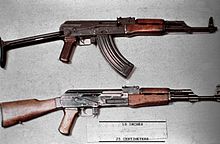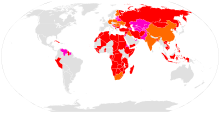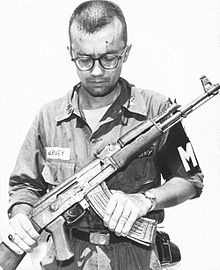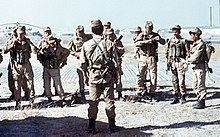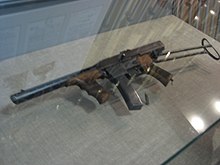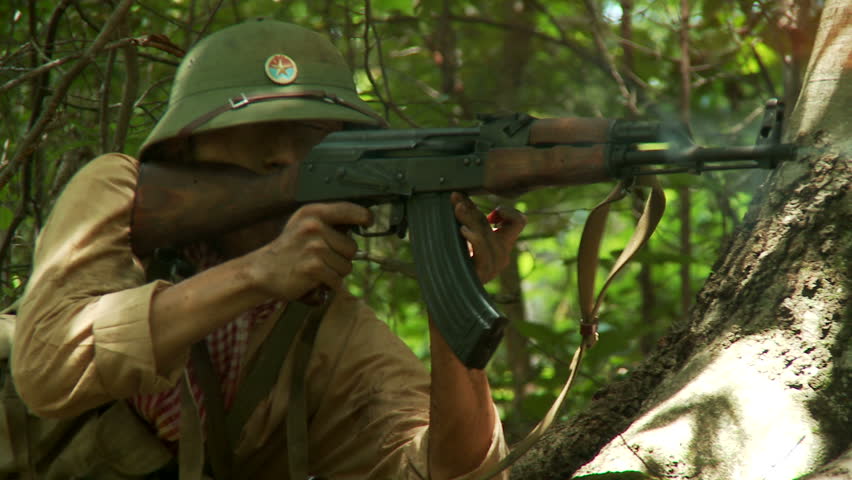)

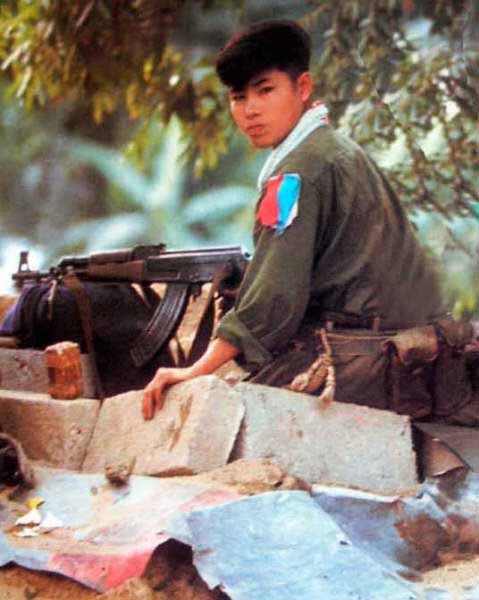


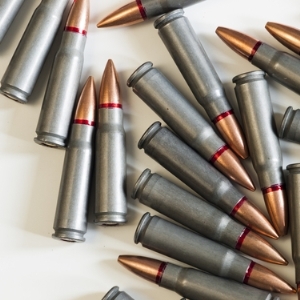
AK-47
The AK-47, or AK as it is officially known (Russian: Автомат Калашникова, translit. Avtomat Kalashnikova, lit. ‘Kalashnikov’s Automatic Rifle’), also known as the Kalashnikov, is a selective-fire(semi-automatic and fully automatic), gas-operated 7.62×39mmassault rifle, developed in the Soviet Union by Mikhail Kalashnikov. It is the originating firearm of the Kalashnikov rifle (or “AK”) family.
Design work on the AK-47 began in the last year of World War II (1945). In 1946, the AK-47 was presented for official military trials, and in 1948, the fixed-stock version was introduced into active service with selected units of the Soviet Army. An early development of the design was the AKS (S—Skladnoy or “folding”), which was equipped with an underfolding metal shoulder stock. In the spring of 1949, the AK-47 was officially accepted by the Soviet Armed Forces[8] and used by the majority of the member states of the Warsaw Pact.
Even after almost seven decades, the model and its variants remain the most popular and widely used assault rifles in the world because of their substantial reliability under harsh conditions, low production costs compared to contemporary Western weapons, availability in virtually every geographic region and ease of use. The AK-47 has been manufactured in many countries and has seen service with armed forces as well as irregular forces and insurgencies worldwide, and was the basis for developing many other types of individual, crew-served and specialised firearms. As of 2004, “Of the estimated 500 million firearms worldwide, approximately 100 million belong to the Kalashnikov family, three-quarters of which are AK-47s”.[3]
Contents
[hide]
History
Origins
During World War II, the Sturmgewehr 44 assault rifle used by German forces made a deep impression on their Soviet counterparts.[9][10] The select-fire rifle was chambered for a new intermediate cartridge, the 7.92×33mm Kurz, and combined the firepower of a submachine gun with the range and accuracy of a rifle.[11][12] On 15 July 1943, an earlier model of the Sturmgewehr was demonstrated before the People’s Commissariat of Arms of the USSR.[13] The Soviets were impressed with the weapon and immediately set about developing an intermediate caliber fully automatic rifle of their own,[9][10] to replace the PPSh-41 submachine guns and outdated Mosin–Nagant bolt-action rifles that armed most of the Soviet Army.[14]
The Soviets soon developed the 7.62×39mm M43 cartridge,[13] the semi-automatic SKS carbine and the RPD light machine gun.[15]Shortly after World War II, the Soviets developed the AK-47 assault rifle, which would quickly replace the SKS in Soviet service.[16][17] In the 1960s, the Soviets introduced the RPK light machine gun, an AK-47 type weapon with a stronger receiver, a longer heavy barrel, and a bipod, that would eventually replace the RPD light machine gun.[15]
Concept
Mikhail Kalashnikov began his career as a weapon designer in 1941, while recuperating from a shoulder wound, which he received during the Battle of Bryansk.[4][18] Kalashnikov himself stated…”I was in the hospital, and a soldier in the bed beside me asked: ‘Why do our soldiers have only one rifle for two or three of our men, when the Germans have automatics?’ So I designed one. I was a soldier, and I created a machine gun for a soldier. It was called an Avtomat Kalashnikova, the automatic weapon of Kalashnikov—AK—and it carried the date of its first manufacture, 1947.”[19]
The AK-47 is best described as a hybrid of previous rifle technology innovations. “Kalashnikov decided to design an automatic rifle combining the best features of the American M1 and the German StG44.”[20] Kalashnikov’s team had access to these weapons and had no need to “reinvent the wheel”. Kalashnikov himself observed: “A lot of Russian Army soldiers ask me how one can become a constructor, and how new weaponry is designed. These are very difficult questions. Each designer seems to have his own paths, his own successes and failures. But one thing is clear: before attempting to create something new, it is vital to have a good appreciation of everything that already exists in this field. I myself have had many experiences confirming this to be so.”[18]
There are claims about Kalashnikov copying other designs, like Bulkin’s TKB-415[21] or Simonov’s AVS-31.[22]
Early designs
Kalashnikov started work on a submachine gun design in 1942[23] and with a light machine gun in 1943.[24][25] “Early in 1944, Kalashnikov was given some M1943 7.62×39mm cartridges and informed that there were several designers working on weapons for this new Soviet small-arms cartridge. It was suggested to him that this new weapon might well lead to greater things, and he undertook work on the new rifle.”[26] In 1944, he entered a design competition with this new 7.62×39mm, semi-automatic, gas-operated, long stroke piston, carbine, strongly influenced by the American M1 Garand.[27] “The rifle that Kalashnikov designed was in the same class as the familiar SKS-45 Simonov with fixed magazine and gas tube above the barrel.”[26] However, this new Kalashnikov design lost out to a Simonov design.[28]
In 1946, a new design competition was initiated to develop a new assault rifle.[29] Kalashnikov submitted an entry. It was gas-operated rifle with a short-stroke gas piston above the barrel, a breech-block mechanism similar to his 1944 carbine, and a curved 30-round magazine.[30] Kalashnikov’s rifles AK-1 (with a milled receiver) and AK-2 (with a stamped receiver) proved to be reliable weapons and were accepted to a second round of competition along with other designs.
These prototypes (also known as the AK-46) had a rotary bolt, a two-part receiver with separate trigger unit housing, dual controls (separate safety and fire selector switches) and a non-reciprocating charging handle located on the left side of the weapon.[30][31] This design had many similarities to the STG 44.[32] In late 1946, as the rifles were being tested, one of Kalashnikov’s assistants, Aleksandr Zaitsev, suggested a major redesign to improve reliability. At first, Kalashnikov was reluctant, given that their rifle had already fared better than its competitors. Eventually, however, Zaitsev managed to persuade Kalashnikov.
In November 1947, the new prototypes (AK-47s) were completed. It utilized a long-stroke gas piston above the barrel. The upper and lower receivers were combined into a single receiver. The selector and safety were combined into a single control-lever/dust-cover on the right side of the rifle. And, the bolt-handle was simply attached to the bolt-carrier. This simplified the design and production of the rifle. The first army trial series began in early 1948.[33] The new rifle proved to be reliable under a wide range of conditions with convenient handling characteristics. In 1949, it was adopted by the Soviet Army as “7.62 mm Kalashnikov assault rifle (AK)”.[8]
Further development
There were many difficulties during the initial phase of production. The first production models had stamped sheet metal receivers with a milled trunnion and butt stock insert, and a stamped body. Difficulties were encountered in welding the guide and ejector rails, causing high rejection rates.[34] Instead of halting production, a heavy[N 2] machined receiver was substituted for the sheet metal receiver. This was a more costly process, but the use of machined receivers accelerated production as tooling and labor for the earlier Mosin–Nagant rifle’s machined receiver were easily adapted.[35] Partly because of these problems, the Soviets were not able to distribute large numbers of the new rifle to soldiers until 1956. During this time, production of the interim SKS rifle continued.[34]
Once the manufacturing difficulties of non milled receivers had been overcome, a redesigned version designated the AKM (M for “modernized” or “upgraded”; in Russian: Автомат Калашникова Модернизированный [Avtomat Kalashnikova Modernizirovanniy]) was introduced in 1959.[36] This new model used a stamped sheet metal receiver and featured a slanted muzzle brake on the end of the barrelto compensate for muzzle rise under recoil. In addition, a hammer retarder was added to prevent the weapon from firing out of battery (without the bolt being fully closed), during rapid or fully automatic fire.[34] This is also sometimes referred to as a “cyclic rate reducer”, or simply “rate reducer”, as it also has the effect of reducing the number of rounds fired per minute during fully automatic fire. It was also roughly one-third lighter than the previous model.[36]
| Receiver type | Description[35] |
|---|---|
| Type 1A/B | The original stamped receiver for the AK-47 first adopted and produced in 1949. The 1B was modified for an underfolding stock with a large hole present on each side to accommodate the hardware for the underfolding stock. |
| Type 2A/B | The first milled receiver made from steel forging. It went into production in 1951 and production ended between 1953 and 1954. The Type 2A has a distinctive socketed metal “boot” connecting the butt stock to the receiver and the milled lightening cut on the sides runs parallel to the barrel. |
| Type 3A/B | “Final” version of the AK-47 milled receiver made from steel bar stock. It went into production between 1953 and 1954. The most ubiquitous example of the milled-receiver AK-47. The milled lightening cut on the sides is slanted to the barrel axis. |
| Type 4A/B | AKM receiver stamped from a smooth 1.0 mm (0.04 in) sheet of steel supported extensively by pins and rivets. It went into production in 1959. Overall, the most-used design in the construction of the AK-series rifles. |
Both licensed and unlicensed production of the Kalashnikov weapons abroad were almost exclusively of the AKM variant, partially due to the much easier production of the stamped receiver. This model is the most commonly encountered, having been produced in much greater quantities. All rifles based on the Kalashnikov design are frequently referred to as AK-47s in the West, although this is only correct when applied to rifles based on the original three receiver types.[37] In most former Eastern Bloc countries, the weapon is known simply as the “Kalashnikov” or “AK”. The differences between the milled and stamped receivers includes the use of rivets rather than welds on the stamped receiver, as well as the placement of a small dimple above the magazine well for stabilization of the magazine.
Replacement
In 1974, the Soviets began replacing their AK-47 and AKM rifles with a newer design, the AK-74, which uses 5.45×39mmammunition. This new rifle and cartridge had only started to be manufactured in Eastern European nations when the Soviet Union collapsed, drastically slowing production of the AK-74 and other weapons of the former Soviet bloc.
Design
The AK-47 was designed to be a simple, reliable fully automatic rifle that could be manufactured quickly and cheaply, using mass production methods that were state of the art in the Soviet Union during the late 1940s.[38] The AK-47 uses a long stroke gas system that is generally associated with great reliability in adverse conditions.[27][39][40] The large gas piston, generous clearances between moving parts, and tapered cartridge case design allow the gun to endure large amounts of foreign matter and fouling without failing to cycle.
Cartridge

Wound Profiles of Russian small-arms ammunition compiled by Dr. Martin Fackler on behalf of the U.S. military
The AK fires the 7.62×39mm cartridge with a muzzle velocity of 715 m/s (2,350 ft/s).[7] The cartridge weight is 16.3 g (0.6 oz), the projectile weight is 7.9 g (122 gr).[41] The original Soviet M43 bullets are 123 grain boat-tail bullets with a copper-plated steel jacket, a large steel core, and some lead between the core and the jacket. The AK has excellent penetration when shooting through heavy foliage, walls or a common vehicle’s metal body and into an opponent attempting to use these things as cover. The 7.62×39mm M43 projectile does not generally fragment when striking an opponent and has an unusual tendency to remain intact even after making contact with bone. The 7.62×39mm round produces significant wounding in cases where the bullet tumbles (yaws) in tissue,[42] but produces relatively minor wounds in cases where the bullet exits before beginning to yaw.[43][44][45] In the absence of yaw, the M43 round can pencil through tissue with relatively little injury.[43][46]
Most, if not all, of the 7.62×39mm ammunition found today is of the upgraded M67 variety. This variety deleted the steel insert, shifting the center of gravity rearward, and allowing the projectile to destabilize (or yaw) at about 3.3 in (8.4 cm), nearly 6.7 in (17 cm) earlier in tissue than the M43 round.[47] This change also reduces penetration in ballistic gelatin to ~25 in (64 cm) for the newer M67 round versus ~29 in (74 cm) for the older M43 round.[47][48] However, the wounding potential of M67 is mostly limited to the small permanent wound channel the bullet itself makes, especially when the bullet yaws.[47]
Operating mechanism

The gas-operated mechanism of a Chinese AK-47
To fire, the operator inserts a loaded magazine, pulls back and releases the charging handle, and then pulls the trigger. In semi-automatic, the firearm fires only once, requiring the trigger to be released and depressed again for the next shot. In fully automatic, the rifle continues to fire automatically cycling fresh rounds into the chamber, until the magazine is exhausted or pressure is released from the trigger. After ignition of the cartridge primer and propellant, rapidly expanding propellant gases are diverted into the gas cylinder above the barrel through a vent near the muzzle. The build-up of gases inside the gas cylinder drives the long-stroke piston and bolt carrier rearward and a cam guide machined into the underside of the bolt carrier along with an ejector spur on the bolt carrier rail guide, rotates the bolt approximately 35° and unlocks it from the barrel extension via a camming pin on the bolt. The moving assembly has about 5.5 mm (0.2 in) of free travel, which creates a delay between the initial recoil impulse of the piston and the bolt unlocking sequence, allowing gas pressures to drop to a safe level before the seal between the chamber and the bolt is broken. The AK-47 does not have a gas valve; excess gases are ventilated through a series of radial ports in the gas cylinder. The Kalashnikov operating system offers no primary extraction upon bolt rotation, but uses an extractor claw to eject the spent cartridge case.[49]
Barrel
The rifle received a barrel with a chrome-lined bore and four right-hand grooves at a 240 mm (1 in 9.45 in) rifling twist rate. The gas block contains a gas channel that is installed at a slanted angle in relation to the bore axis. The muzzle is threaded for the installation of various muzzle devices such as a muzzle brake or a blank-firing adaptor.
Gas block
The gas block of the AK-47 features a cleaning rod capture or sling loop. Gas relief ports that alleviate gas pressure are placed horizontally in a row on the gas cylinder.
Fire selector

Việt Cộng soldier armed with an AK-47, standing beneath the flag of the National Liberation Front of South Vietnam
The fire selector is a large lever located on the right side of the rifle, it acts as a dust-cover and prevents the charging handle from being pulled fully to the rear when it is on safe.[50] It is operated by the shooter’s right fore-fingers and has 3 settings: safe (up), full-auto (center), and semi-auto (down).[50] The reason for this is that under stress a soldier will push the selector lever down with considerable force bypassing the full-auto stage and setting the rifle to semi-auto.[50] To set the AK-47 to full-auto requires the deliberate action of centering the selector lever.[50]To operate the fire selector lever, right handed shooters have to briefly remove their right hand from the pistol grip, which is ergonomically sub-optimal. Some AK-type rifles also have a more traditional selector lever on the left side of the receiver just above the pistol grip.[50] This lever is operated by the shooter’s right thumb and has three settings: safe (forward), full-auto (center), and semi-auto (backward).[50]
Sights
The AK-47 uses a notched rear tangent iron sight calibrated in 100 m (109 yd) increments from 100 to 800 m (109 to 875 yd).[51] The front sight is a post adjustable for elevation in the field. Horizontal adjustment requires a special drift tool and is done by the armory before issue or if the need arises by an armorer after issue. The sight line elements are approximately 48.5 mm (1.9 in) over the bore axis. The “point-blank range” battle zero setting “П” on the 7.62×39mm AK-47 rear tangent sight element corresponds to a 300 m (328 yd) zero.[51][52] These settings mirror the Mosin–Nagant and SKS rifles, which the AK-47 replaced. For the AK-47 combined with service cartridges, the 300 m battle zero setting limits the apparent “bullet rise” within approximately −5 to +31 cm (−2.0 to 12.2 in) relative to the line of sight. Soldiers are instructed to fire at any target within this range by simply placing the sights on the center of mass (the belt buckle, according to Russian and former Soviet doctrine) of the enemy target. Any errors in range estimation are tactically irrelevant, as a well-aimed shot will hit the torso of the enemy soldier. Some AK-type rifles have a front sight with a flip-up luminous dot that is calibrated at 50 m (55 yd), for improved night fighting.[51]
Furniture
The AK-47 was originally equipped with a buttstock, handguard and an upper heat guard made from solid wood. With the introduction of the Type 3 receiver the buttstock, lower handguard and upper heatguard were manufactured from birchplywood laminates.[35] Such engineered woods are stronger and resist warping better than the conventional one-piece patterns, do not require lengthy maturing, and are cheaper. The wooden furniture was finished with the Russian amber shellac finishing process.[citation needed] AKS and AKMS models featured a downward-folding metal butt-stock similar to that of the German MP40 submachine-gun, for use in the restricted space in the BMP infantry combat vehicle, as well as by paratroops. All 100 series AKs use plastic furniture with side-folding stocks.
Magazines
The standard magazine capacity is 30 rounds. There are also 10, 20, and 40-round box magazines, as well as 75-round drum magazines.
The AK-47’s standard 30-round magazines have a pronounced curve that allows them to smoothly feed ammunition into the chamber. Their heavy steel construction combined with “feed-lips” (the surfaces at the top of the magazine that control the angle at which the cartridge enters the chamber) machined from a single steel billet makes them highly resistant to damage. These magazines are so strong that “Soldiers have been known to use their mags as hammers, and even bottle openers”.[53][54] This contributes to the AK-47 magazine being more reliable, but makes it heavier than U.S. and NATO magazines.
The early slab-sided steel AK-47 30-round detachable box magazines had 1 mm (0.039 in) sheet-metal bodies and weigh 0.43 kg (0.95 lb) empty.[40] The later steel AKM 30-round magazines had lighter sheet-metal bodies with prominent reinforcing ribs weighing 0.33 kg (0.73 lb) empty.[40][55] To further reduce weight, a light weight magazine with an aluminum body with a prominent reinforcing waffle rib pattern weighing 0.19 kg (0.42 lb) empty was developed for the AKM that proved to be too fragile and the small issued amount of these magazines were quickly withdrawn from service. As a replacement steel-reinforced 30-round plastic 7.62×39mm box magazines were introduced. These rust-coloredmagazines weigh 0.24 kg (0.53 lb) empty and are often mistakenly identified as being made of Bakelite (a phenolic resin), but were actually fabricated from two-parts of AG-S4 molding compound (a glass-reinforced phenol-formaldehyde binder impregnated composite), assembled using an epoxy resinadhesive.[56][57][58] Noted for their durability, these magazines did however compromise the rifle’s camouflage and lacked the small horizontal reinforcing ribs running down both sides of the magazine body near the front that were added on all later plastic magazine generations.[58] A second generation steel-reinforced dark-brown (color shades vary from maroonto plum to near black) 30-round 7.62×39mm magazine was introduced in the early 1980s, fabricated from ABS plastic. The third generation steel-reinforced 30-round 7.62×39mm magazine is similar to the second generation, but is darker colored and has a matte nonreflective surface finish. The current issue steel-reinforced matte true black nonreflective surface finished 7.62×39mm 30-round magazines, fabricated from ABS plastic weigh 0.25 kg (0.55 lb) empty.[7]
Early steel AK-47 magazines are 9.75 in (248 mm) long; the later ribbed steel AKM and newer plastic 7.62×39mm magazines are about 1 in (25 mm) shorter.[59][60]
The transition from steel to mainly plastic magazines yields a significant weight reduction and allows a soldier to carry more ammunition for the same weight.
| Rifle | Cartridge | Cartridge weight | Weight of empty magazine | Weight of loaded magazine | Max. 10.12 kg (22.3 lb) ammunition load* |
|---|---|---|---|---|---|
| AK-47 (1949) | 7.62×39mm | 16.3 g (252 gr) | slab-sided steel 430 g (0.95 lb) |
30-rounds 916 g (2.019 lb)[40] |
11 magazines for 330 rounds 10.08 kg (22.2 lb) |
| AKM(1959) | 7.62×39mm | 16.3 g (252 gr) | ribbed stamped-steel 330 g (0.73 lb) |
30-rounds 819 g (1.806 lb)[40][55] |
12 magazines for 360 rounds 9.83 kg (21.7 lb) |
| AK-103(1994) | 7.62×39mm | 16.3 g (252 gr) | steel-reinforced plastic 250 g (0.55 lb) |
30-rounds 739 g (1.629 lb)[40][55] |
13 magazines for 390 rounds 9.61 kg (21.2 lb) |
All 7.62×39mm AK magazines are backwards compatible with older AK variants.
10.12 kg (22.3 lb) is the maximum amount of ammo that the average soldier can comfortably carry. It also allows for best comparison of the three most common 7.62×39mm AK magazines.
Most Yugoslavian and some East German AK magazines were made with cartridge followers that hold the bolt open when empty; however, most AK magazine followers allow the bolt to close when the magazine is empty.
Accessories

AK-103 with GP-34 Grenade Launcher
Accessories supplied with the rifle include a 387 mm (15.2 in) long 6H3 bayonetfeaturing a 200 mm (7.9 in) long spear point blade. The AK-47 bayonet is installed by slipping the 17.7 mm (0.70 in) diameter muzzle ring around the muzzle and latching the handle down on the bayonet lug under the front sight base.[61]
All current model AKM rifles can mount under-barrel 40 mm grenade launchers such as the GP-25 and its variants, which can fire up to 20 rounds per minute and have an effective range of up to 400 metres.[62] The main grenade is the VOG-25 (VOG-25M) fragmentation grenade which has a 6 m (9 m) (20 ft (30 ft)) lethality radius. The VOG-25P/VOG-25PM (“jumping”) variant explodes 0.5–1 metre (1.6–3.3 ft) above the ground.[63]
The AK-47 can also mount a (rarely used) cup-type grenade launcher, the Kalashnikov grenade launcher that fires standard RGD-5 Soviet hand-grenades. The maximum effective range is approximately 150 meters.[64] This launcher can also be used to launch tear-gas and riot control grenades.
All current AKs (100 series) and some older models, have side rails for mounting a variety of scopes and sighting devices, such as the PSO-1 Optical Sniper Sight.[65] The side rails allow for the removal and remounting of optical accessories without interfering with the zeroing of the optic. However, the 100 series side folding stocks cannot be folded with the optics mounted.
Characteristics
Service life
The AK-47 and its variants are made in dozens of countries, with “quality ranging from finely engineered weapons to pieces of questionable workmanship.”[66] As a result, the AK-47 has a service/system life of approximately 6,000,[67] to 10,000,[68] to 15,000[69] rounds. The AK-47 was designed to be a cheap, simple, easy to manufacture assault rifle,[70]perfectly matching Soviet military doctrine that treats equipment and weapons as disposable items.[71] As units are often deployed without adequate logistical support and dependent on “battlefield cannibalization” for resupply, it is actually more cost-effective to replace rather than repair weapons.[71]
The AK-47 has small parts and springs that need to be replaced every few thousand rounds. However, “Every time it is disassembled beyond the field stripping stage, it will take some time for some parts to regain their fit, some parts may tend to shake loose and fall out when firing the weapon. Some parts of the AK-47 line are riveted together. Repairing these can be quite a hassle, since the end of the rivet has to be ground off and a new one set after the part is replaced.”[51]
Variants
- Early variants (7.62×39mm)
- Issue of 1948/49: Type 1: The very earliest models, stamped sheet metal receiver, are now very rare.
- Issue of 1951: Type 2: Has a milled receiver. Barrel and chamber are chrome plated to resist corrosion.
- Issue of 1954/55: Type 3: Lightened, milled receiver variant. Rifle weight is 3.47 kg (7.7 lb).[5]
- AKS (AKS-47): Type 1, 2, or 3 receiver: Featured a downward-folding metal stock similar to that of the German MP40, for use in the restricted space in the BMP infantry combat vehicle, as well as by paratroops.
- AKN (AKSN): Night scope rail.[72]
- Modernized (7.62×39mm)
- AKM: A simplified, lighter version of the AK-47; Type 4 receiver is made from stamped and riveted sheet metal. A slanted muzzle device was added to counter climb in automatic fire. Rifle weight is 3.1 kg (6.8 lb)[7] due to the lighter receiver. This is the most ubiquitous variant of the AK-47.
- RPK: Hand-held machine gun version with longer barrel and bipod. The variants—RPKS, RPKN (RPKSN), RPKL (RPKSL)—mirror AKM variants. The “S” variants have a side-folding wooden stock.
For the further developed AK models, see Kalashnikov rifles.
Production
Outside of the Soviet Union/Russia
Kalashnikov Concern (formerly Izhmash) has repeatedly claimed that the majority of foreign manufacturers are producing AK type rifles without proper licensing.[74][75]
| This section needs additional citations for verification. (February 2013) (Learn how and when to remove this template message) |
| Country | Military variant(s) |
|---|---|
| Albania | Automatiku Shqiptar model 56 (ASH-78 Tip-1) Albanian Automatic Assault Rifle Model 56 Type-1 [Made in Poliçan Arsenal] (Straight forward copy of Type 56, which in turn is a clone of the Soviet AKM rifle)
Automatiku Shqiptar Tipi 1982 (ASH-82) Albanian Automatic Assault Rifle Type 1982 [Made in Poliçan Arsenal] (Straight forward copy of AKMS) Automatiku Shqiptar model 56 (ASH-78 Tip-2) Albanian Light Machine Gun [Made in Poliçan Arsenal] (Straight forward copy of RPK) Automatiku Shqiptar model 56 (ASH-78 Tip-3) Albanian Automatic Hybrid Rifle Model 56 Type-3 [Made in Poliçan Arsenal] (Hybrid rifle for multi-purpose roles mainly Marksman rifle with secondary assault rifle and grenade launcher capability) Several other unnamed & unidentified versions of the AKMS have been produced mainly with short barrels similar to the Soviet AKS-74U mainly for special forces, Tank & Armoured crew also for Helicopter pilots and police. There have also been modifications and fresh production of heavily modified ASh-82 (AKMS) with SOPMOD accessories, mainly for Albania’s special forces RENEA & exports.[original research?] |
| Armenia | K-3 (bullpup, 5.45×39mm) |
| Azerbaijan | Khazri (AK-74M)[76] |
| Bangladesh | Chinese Type 56 |
| Bulgaria | AKK/AKKS (Type 3 AK-47/w. side-folding buttstock)
AKKMS (AKMS), AKKN-47 (fittings for NPSU night sights) AK-47M1 (Type 3 with black polymer furniture) AK-47MA1/AR-M1 (same as -M1, but in 5.56mm NATO) AKS-47M1 (AKMS in 5.56×45mm NATO) AKS-47S (AK-47M1, short version, with East German folding stock, laser aiming device) AKS-47UF (short version of -M1, Russian folding stock), AR-SF (same as −47UF, but 5.56mm NATO) AKS-93SM6 (similar to −47M1, cannot use grenade launcher) RKKS (RPK), AKT-47 (.22 rimfire training rifle) |
| Cambodia | Chinese Type 56, Soviet AK-47, and AKM |
| People’s Republic of China | Type 56 |
| Colombia | Galil ACE |
| Croatia | APS-95 |
| Cuba | AKM[77] |
| East Germany[78] | MPi-K/MPi-KS (AK-47/AKS)
MPi-KM (AKM; wooden and plastic stock), MPi-KMS-72 (side-folding stock), MPi-KMS-K (carbine) MPi-AK-74N (AK-74), MPi-AKS-74N (side-folding stock), MPi-AKS-74NK (carbine) KK-MPi Mod.69 (.22 LR select-fire trainer) |
| Egypt | AK-47, Misr assault rifle (AKMS), Maadi ARM (AKM) |
| Ethiopia | AK-47, AK-103 (manufactured locally at the State-run Gafat Armament Engineering Complex as the Et-97/1)[79] |
| Finland | Rk 62, Valmet M76 (other names Rk 62 76, M62/76), Valmet M78 (light machine gun), Rk 95 Tp |
| Hungary[80] | AK-55 (domestic manufacture of the 2nd Model AK-47)
AKM-63 (also known as AMD-63 in the US; modernized AK-55), AMD-65M (modernized AKM-63, shorter barrel and side-folding stock), AMP-69 (rifle grenade launcher) AK-63F/D (other name AMM/AMMSz), AK-63MF (modernized) NGM-81 (5.56×45mm NATO; fixed and under-folding stock) |
| India | INSAS (fixed and side-folding stock), KALANTAK (carbine), INSAS light machine gun (fixed and side-folding stock), a local unlicensed version with carbon fibre furniture designated as AK-7 [81]
Trichy Assault Rifle 7.62 mm, manufactured by Ordnance Factory Tiruchirappalli of Ordnance Factories Board[82] |
| Iran | KLS/KLF (AK-47/AKS), KLT (AKMS) |
| Iraq | Tabuk Sniper Rifle, Tabuk Assault Rifle (with fixed or underfolding stock, outright clones of Yugoslavian M70 rifles series), Tabuk Short Assault Rifle (carbine) |
| Israel | IMI Galil: AR (assault/battle rifle), ARM (assault rifle/light machine gun), SAR (carbine), MAR (compact carbine), Sniper (sniper rifle), SR-99 (sniper rifle)
|
| Italy | Bernardelli VB-STD/VB-SR (Galil AR/SAR)[83] |
| Nigeria | Produced by the Defence Industries Corporation of Nigeria as OBJ-006[84][85] |
| North Korea | Type 58A/B (Type 3 AK-47/w. stamped steel folding stock), Type 68A/B (AKM/AKMS), Type 88A/B-2 (AK-74/AKS-74/w. top folding stock)[86][87] |
| Pakistan | Reverse engineered by hand and machine in Pakistan’s highland areas (see Khyber Pass Copy) near the border of Afghanistan; more recently the Pakistan Ordnance Factories started the manufacture of an AK-47/AKM clone called PK-10[88] |
| Poland[89] | pmK (kbk AK) / pmKS (kbk AKS) (name has changed from pmK – “pistolet maszynowy Kałasznikowa”, Kalashnikov SMG to the kbk AK – “karabinek AK”, Kalashnikov Carbine in the mid-1960s) (AK-47/AKS)
kbkg wz. 1960 (rifle grenade launcher), kbkg wz. 1960/72 (modernized) kbk AKM / kbk AKMS (AKM/AKMS) kbk wz. 1988 Tantal (5.45×39mm), skbk wz. 1989 Onyks (compact carbine) kbs wz. 1996 Beryl (5.56×45mm), kbk wz. 1996 Mini-Beryl (compact carbine) |
| Romania | PM md. 63/65 (AKM/AKMS), PM md. 80, PM md. 90, collectively exported under the umbrella name AIM or AIMS
PA md. 86 (AK-74), exported as the AIMS-74 PM md. 90 short barrel, PA md. 86 short barrel, exported as the AIMR PSL (designated marksman rifle; other names PSL-54C, Romak III, FPK and SSG-97) |
| South Africa | R4 assault rifle, Truvelo Raptor, Vektor CR-21 (bullpup) |
| Sudan | MAZ[90] (based on the Type 56) |
| Ukraine | Vepr (bullpup, 5.45×39mm), Malyuk (bullpup)[91] |
| United States | Century Arms: C39 (AK-47 var.), RAS47 (AKM var.), and C39v2 (AK-47 var.)), InterOrdnance: AKM247 (AKM var.) M214 (pistol), Palmetto State Armory: PSAK-47 (AKM var.), Arsenal Inc: SA M-7 (AK-47 var.), Destructive Devices Industries: DDI 47S (AKM var.) DDI 47M (AK-47 var), Rifle Dynamics: RD700 and other custom build AK / AKM guns |
| Vietnam | AKM-1 (AKM), TUL-1 (RPK), Galil Ace 31/32 |
| Venezuela | License granted, factory under construction[92] |
| Yugoslavia/Serbia | M64, M70, M72, M76, M77, M80, M82, M85, M90, M91, M92, M99, M21 |
Accuracy potential
The AK-47’s accuracy has always been considered to be “good enough” to hit an adult male torso out to about 300 m (328 yd),[93][94] though even experts firing from prone or bench rest positions at this range were observed to have difficulty placing ten consecutive rounds on target.[95] Later designs did not significantly improve its accuracy.[95] An AK can fire a 10-shot group of 5.9 in (15 cm) at 100 m (109 yd),[96] and 17.5 in (44 cm) at 300 m (328 yd)[95] The newer stamped-steel receiver AKM models, while more rugged and less prone to metal fatigue, are actually less accurate than the forged/milled receivers of their predecessors: the milled AK-47s are capable of shooting 3 to 5 in (8 to 13 cm) groups at 100 yd (91 m), whereas the stamped AKMs are capable of shooting 4 to 6 in (10 to 15 cm) groups at 100 yd (91 m).[94]
The best shooters are able to hit a man-sized target at 800 m (875 yd) within five shots (firing from prone or bench rest position) or ten shots (standing).[97]
|
|
The following table represents the Russian method for determining accuracy and it is far more complex than Western methods. In the West, one fires a group of shots into the target and then simply measure the overall diameter of the group. The Russians on the other-hand, fire a group of shots into the target. They then draw two circles on the target. One for the maximum vertical dispersion of hits and one for the maximum horizontal dispersion of hits. They then disregard the hits on the outer part of the target and only count half of the hits (50% or R50) on the inner part of the circles. This dramatically reduces the overall diameter of the groups. They then use both the vertical and horizontal measurements of the reduced groups to measure accuracy. This method cannot be converted and is not comparable to western methods for determining accuracy.
| AK-47 semi-automatic and short burst dispersion with 57-N-231 steel core service ammunition[98] | ||||||
|---|---|---|---|---|---|---|
| Range | Vertical accuracy of fire (R50) semi-automatic | Horizontal accuracy of fire (R50) semi-automatic | Vertical accuracy of fire (R50) short burst | Horizontal accuracy of fire (R50) short burst | Remaining bullet energy | Remaining bullet velocity |
| 0 m (0 yd) | 0 cm (0.0 in) | 0 cm (0.0 in) | 0 cm (0.0 in) | 0 cm (0.0 in) | 2,036 J (1,502 ft·lbf) | 718 m/s (2,356 ft/s) |
| 100 m (109 yd) | 8 cm (3.1 in) | 4 cm (1.6 in) | 9 cm (3.5 in) | 11 cm (4.3 in) | 1,540 J (1,140 ft·lbf) | 624 m/s (2,047 ft/s) |
| 200 m (219 yd) | 11 cm (4.3 in) | 8 cm (3.1 in) | 18 cm (7.1 in) | 22 cm (8.7 in) | 1,147 J (846 ft·lbf) | 539 m/s (1,768 ft/s) |
| 300 m (328 yd) | 17 cm (6.7 in) | 12 cm (4.7 in) | 27 cm (10.6 in) | 33 cm (13.0 in) | 843 J (622 ft·lbf) | 462 m/s (1,516 ft/s) |
| 400 m (437 yd) | 23 cm (9.1 in) | 16 cm (6.3 in) | 31 cm (12.2 in) | 44 cm (17.3 in) | 618 J (456 ft·lbf) | 395 m/s (1,296 ft/s) |
| 500 m (547 yd) | 29 cm (11.4 in) | 20 cm (7.9 in) | 46 cm (18.1 in) | 56 cm (22.0 in) | 461 J (340 ft·lbf) | 342 m/s (1,122 ft/s) |
| 600 m (656 yd) | 35 cm (13.8 in) | 24 cm (9.4 in) | 56 cm (22.0 in) | 67 cm (26.4 in) | 363 J (268 ft·lbf) | 303 m/s (994 ft/s) |
| 700 m (766 yd) | 42 cm (16.5 in) | 29 cm (11.4 in) | 66 cm (26.0 in) | 78 cm (30.7 in) | 314 J (232 ft·lbf) | 282 m/s (925 ft/s) |
| 800 m (875 yd) | 49 cm (19.3 in) | 34 cm (13.4 in) | 76 cm (29.9 in) | 89 cm (35.0 in) | 284 J (209 ft·lbf) | 268 m/s (879 ft/s) |
- R50 means the closest 50 percent of the shot group will all be within a circle of the mentioned diameter.
In general, this is an improvement with respect to firing accuracy to the AK-47 and the AKM. The vertical and horizontal mean (R50) deviations with service ammunition at 800 m (875 yd) for AK platforms are.
| SKS, AK-47, AKM, and AK-74 dispersion at 800 m (875 yd) | |||
|---|---|---|---|
| Rifle | Firing mode | Vertical accuracy of fire (R50) | Horizontal accuracy of fire (R50) |
| SKS (1945) | semi-automatic | 38 cm (15.0 in) | 29 cm (11.4 in) |
| AK-47 (1949) | semi-automatic | 49 cm (19.3 in) | 34 cm (13.4 in) |
| AK-47 (1949) | short burst | 76 cm (29.9 in) | 89 cm (35.0 in) |
| AKM (1959) | short burst | 64 cm (25.2 in) | 90 cm (35.4 in) |
| AK-74 (1974) | short burst | 48 cm (18.9 in) | 64 cm (25.2 in) |
The single-shot hit-probability on the NATO E-type Silhouette Target (a human upper body half and head silhouette) of the AK-47 and the later developed AK-74, M16A1 and M16A2 assault rifles were measured by the US military under ideal proving ground conditions in the 1980s as follows:
| Single-shot hit-probability on Crouching Man (NATO E-type Silhouette) Target[99] | ||||||||||
|---|---|---|---|---|---|---|---|---|---|---|
| Rifle | Chambering | Hit-probability (With no range estimation or aiming errors) | ||||||||
| 50 meters | 100 meters | 200 meters | 300 meters | 400 meters | 500 meters | 600 meters | 700 meters | 800 meters | ||
| AK-47 (1949) | 7.62×39mm | 100% | 100% | 99% | 94% | 82% | 67% | 54% | 42% | 31% |
| AK-74(1974) | 5.45×39mm | 100% | 100% | 100% | 99% | 93% | 81% | 66% | 51% | 34% |
| M16A1(1967) | 5.56×45mm NATO M193 | 100% | 100% | 100% | 100% | 96% | 87% | 73% | 56% | 39% |
| M16A2(1982) | 5.56×45mm NATOSS109/M855 | 100% | 100% | 100% | 100% | 98% | 90% | 79% | 63% | 43% |
Under worst field exercise circumstances, due to range estimation and aiming errors, the hit probabilities for the tested assault rifles were drastically reduced with differences without operational significance.
Users

AK-47’s of the PAIGC-liberation movement, ready to be transported from Senegal to Guinea-Bissau, 1973
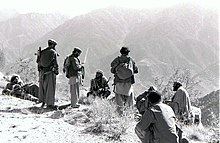
During the Soviet war in Afghanistan in the 1980s, several sources simultaneously armed both sides of the Afghan conflict, filling the country with AK-47s and their derivatives.[100]
 Afghanistan[101]
Afghanistan[101] Albania[102]
Albania[102] Algeria[102]
Algeria[102] Angola[102]
Angola[102] Armenia[102]
Armenia[102] Azerbaijan[102][103]
Azerbaijan[102][103] Bangladesh[102]
Bangladesh[102] Belarus[102]
Belarus[102] Benin[102]
Benin[102] Bosnia and Herzegovina[102]
Bosnia and Herzegovina[102] Botswana[102]
Botswana[102] Bulgaria[102]
Bulgaria[102] Burkina Faso[104][105][106]
Burkina Faso[104][105][106] Burundi[107][108]
Burundi[107][108] Cambodia[102]
Cambodia[102] Cameroon[109][110]
Cameroon[109][110] Cape Verde[102]
Cape Verde[102] Central African Republic[102]
Central African Republic[102] Chad[102]
Chad[102] Chile[111]
Chile[111] People’s Republic of China: Type 56 variant was used.[112]
People’s Republic of China: Type 56 variant was used.[112] Comoros[102]
Comoros[102] Republic of the Congo[102]
Republic of the Congo[102] Democratic Republic of the Congo[102]
Democratic Republic of the Congo[102] Cuba[102]
Cuba[102] Djibouti[113][114]
Djibouti[113][114] East Germany[115]
East Germany[115] Egypt[102]
Egypt[102] Eritrea[102]
Eritrea[102] Ethiopia[102]
Ethiopia[102] El Salvador[116]
El Salvador[116] Fiji[117]
Fiji[117] Finland: Rk 62, Rk 95 Tp.
Finland: Rk 62, Rk 95 Tp. Gabon[102]
Gabon[102] Gambia[118][119][120][121]
Gambia[118][119][120][121] Ghana[122][123]
Ghana[122][123] Greece: EKAM counter-terrorist unit of the Hellenic Police.[124][125]
Greece: EKAM counter-terrorist unit of the Hellenic Police.[124][125] Grenada[126]
Grenada[126] Georgia[102]
Georgia[102] Guatemala[127]
Guatemala[127] Guinea[102]
Guinea[102] Equatorial Guinea[102]
Equatorial Guinea[102] Guinea-Bissau[102]
Guinea-Bissau[102] Guyana[102]
Guyana[102] Hungary[102]
Hungary[102] India:[102] Used by Force One.[128]
India:[102] Used by Force One.[128] Indonesia: Still used by TNI-AD, TNI-AL, TNI-AU, and Police[citation needed]
Indonesia: Still used by TNI-AD, TNI-AL, TNI-AU, and Police[citation needed] Iran[102]
Iran[102] Iraq[101][102]
Iraq[101][102] Israel: Widely used by Israeli Special Forces Units from the 1960 – 1980s.[129]
Israel: Widely used by Israeli Special Forces Units from the 1960 – 1980s.[129] Ivory Coast[130][131][132]
Ivory Coast[130][131][132] Kazakhstan[102]
Kazakhstan[102] Kenya[133]
Kenya[133] North Korea: Type 58 variants were used.[102]
North Korea: Type 58 variants were used.[102] Kurdistan – Peshmerga
Kurdistan – Peshmerga Laos[102]
Laos[102] Kuwait[134]
Kuwait[134] Lebanon[102]
Lebanon[102] Liberia[102]
Liberia[102] Libya[102]
Libya[102] Macedonia[102][135]
Macedonia[102][135] Madagascar[102]
Madagascar[102] Mali[102]
Mali[102] Malta: Type 56 variant.[102]
Malta: Type 56 variant.[102] Mauritania[136][137][138]
Mauritania[136][137][138] Moldova[102]
Moldova[102] Mongolia[102]
Mongolia[102] Morocco[102]
Morocco[102] Mozambique[102]
Mozambique[102] Myanmar: Used by the Myanmar Police Force (include the Chinese Type 56).[citation needed]
Myanmar: Used by the Myanmar Police Force (include the Chinese Type 56).[citation needed] Namibia[102]
Namibia[102] Niger[139][140][141]
Niger[139][140][141] Nigeria[84][85]
Nigeria[84][85] Oman[102]
Oman[102] Pakistan: Type 56[142] and AK-103[143] used.
Pakistan: Type 56[142] and AK-103[143] used. Palestinian Authority[144]
Palestinian Authority[144] Paraguay[145]
Paraguay[145] Peru[102]
Peru[102] Philippines: Used by the Santiago City PNP.[146]
Philippines: Used by the Santiago City PNP.[146] Poland:[21] Replaced by AKM, Tantal and Beryl.
Poland:[21] Replaced by AKM, Tantal and Beryl. Qatar[102]
Qatar[102] Rhodesia[147]
Rhodesia[147] Romania[102]
Romania[102] Russia:[21] Replaced by the AK-74 since 1974.
Russia:[21] Replaced by the AK-74 since 1974. Rwanda[148]
Rwanda[148] Sahrawi Arab Democratic Republic[149]
Sahrawi Arab Democratic Republic[149] Sao Tome and Principe[102]
Sao Tome and Principe[102] Saudi Arabia
Saudi Arabia Senegal[150]
Senegal[150] Serbia[102]
Serbia[102] Seychelles[102]
Seychelles[102] Sierra Leone[102]
Sierra Leone[102] Slovenia[102]
Slovenia[102] Somalia[102]
Somalia[102] South Africa: Used by the Special Forces Brigade.[151]
South Africa: Used by the Special Forces Brigade.[151] Sri Lanka: Type 56 variant.[102]
Sri Lanka: Type 56 variant.[102] Sudan[102]
Sudan[102] South Sudan[citation needed]
South Sudan[citation needed] Suriname[102]
Suriname[102] Syria[102]
Syria[102] Tajikistan[102]
Tajikistan[102] Tanzania[102]
Tanzania[102] Togo[102]
Togo[102] Turkey[102]
Turkey[102] Turkmenistan[102]
Turkmenistan[102] Uganda[102]
Uganda[102] Ukraine[102]
Ukraine[102] Dominican Republic[102]
Dominican Republic[102] UAE[102]
UAE[102] Uzbekistan[102]
Uzbekistan[102] Vietnam: Type 56 variants and Type 58 variants were used extensively by the Viet Cong.[112]
Vietnam: Type 56 variants and Type 58 variants were used extensively by the Viet Cong.[112] Yemen[102]
Yemen[102] Yugoslavia[21]
Yugoslavia[21] Zambia[102]
Zambia[102] Zimbabwe[102]
Zimbabwe[102]
Illicit trade
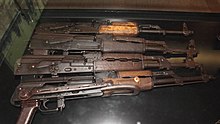
AK-47 copies confiscated from Somali pirates by Finnish mine-layer Pohjanmaa during Operation Atalanta, photographed in Manege Military Museum. The stocks are missing on the top three AKs
Throughout the world, the AK and its variants are commonly used by governments, revolutionaries, terrorists, criminals, and civilians alike. In some countries, such as Somalia, Rwanda, Mozambique, Congo and Tanzania, the prices for Black Market AKs are between $30 and $125 per weapon and prices have fallen in the last few decades due to mass counterfeiting.[152] In Kenya, “an AK-47 fetches five head of cattle (about 10,000 Kenya shillings or 100 U.S. dollars) when offered for barter, but costs almost half that price when cash is paid”.[153] There are places around the world where AK type weapons can be purchased on the Black Market “for as little as $6, or traded for a chicken or a sack of grain”.[154][155][156]
The AK-47 has also spawned a cottage industry of sorts and has been copied and manufactured (one gun at a time) in small shops around the world (see Khyber Pass Copy).[157][158] The estimated numbers of AK-type weapons vary greatly. The Small Arms Survey suggest that “between 70 and 100 million of these weapons have been produced since 1947”.[159] The World Bank estimates that out of the 500 million total firearms available worldwide, 100 million are of the Kalashnikov family, and 75 million are AK-47s.[3]Because AK-type weapons have been made in many countries, often illicitly, it is impossible to know how many really exist.[160]
Cultural influence and impact
— Larry Kahaner, author of AK-47: The Weapon That Changed the Face of War[161]
During the Cold War, the Soviet Union and the People’s Republic of China, as well as United States and other NATO nations supplied arms and technical knowledge to numerous countries and rebel forces around the world. During this time the Western countries used relatively expensive automatic rifles, such as the FN FAL, the HK G3, the M14, and the M16. In contrast, the Russians and Chinese used the AK-47; its low production cost and ease of manufacture allow them to make AKs in vast numbers.
In the pro-communist states, the AK-47 became a symbol of third-world revolution. During the 1980s, the Soviet Union became the principal arms dealer to countries embargoed by Western nations, including Middle Eastern nations such as Iran, Libya, and Syria, which welcomed Soviet Union backing against Israel. After the fall of the Soviet Union, AK-47s were sold both openly and on the black market to any group with cash, including drug cartels and dictatorial states, and more recently they have been seen in the hands of Islamic groups such as Al-Qaeda, ISIL, and the Taliban in Afghanistan and Iraq, and FARC, Ejército de Liberación Nacional guerrillas in Colombia.[161]
In Russia, the Kalashnikov is a tremendous source of national pride.[162] “The family of the inventor of the world’s most famous assault rifle, Mikhail Kalashnikov, has authorized German engineering company MMI to use the well-known Kalashnikov name on a variety of not-so-deadly goods.”[163] In recent years, Kalashnikov Vodka has been marketed with souvenir bottles in the shape of the AK-47 Kalashnikov.[164][165] There are also Kalashnikov watches,[166] umbrellas,[167] and knives.[168][169]
The Kalashnikov Museum (also called the AK-47 museum) opened on 4 November 2004 in Izhevsk, Udmurt Republic. This city is in the Ural Region of Russia. The museum chronicles the biography of General Kalashnikov and documents the invention of the AK-47. The museum complex of Kalashnikov’s small arms, a series of halls, and multimedia exhibitions are devoted to the evolution of the AK-47 assault rifle and attracts 10,000 monthly visitors.[170] Nadezhda Vechtomova, the museum director, stated in an interview that the purpose of the museum is to honor the ingenuity of the inventor and the hard work of the employees and to “separate the weapon as a weapon of murder from the people who are producing it and to tell its history in our country”. On 19 September 2017 a 9 metres (30 ft) monument of Kalashnikov was unveiled in central Moscow. A protester, later detained by police, attempted to unfurl a banner reading “a creator of weapons is a creator of death”.[171]
The proliferation of this weapon is reflected by more than just numbers. The AK-47 is included in the flag of Mozambiqueand its emblem, an acknowledgment that the country gained its independence in large part through the effective use of their AK-47s.[172] It is also found in the coats of arms of East Timor and the revolution era Burkina Faso, as well as in the flags of Hezbollah, Syrian Resistance, FARC-EP, the New People’s Army, TKP/TIKKO and the International Revolutionary People’s Guerrilla Forces.
Some Western countries associate the AK-47 with their enemies; both Cold War era and present-day. For example, Western movies often portray criminals, gang members and terrorists using AK-47s. For these reasons, in the U.S. and Western Europe, the AK-47 is stereotypically regarded as the weapon of choice of insurgents, gangsters and terrorists. Conversely, throughout the developing world, the AK-47 can be positively attributed with revolutionaries against foreign occupation, imperialism, or colonialism.[161]
The AK-47 made an appearance in U.S. popular culture as a recurring focus in the Nicolas Cage film Lord of War (2005). Numerous monologues in the movie focus on the weapon, and its effects on global conflict and the gun runningmarket.[173]
In 2006, the Colombian musician and peace activist César López devised the escopetarra, an AK converted into a guitar. One sold for US$17,000 in a fundraiser held to benefit the victims of anti-personnel mines, while another was exhibited at the United Nations’ Conference on Disarmament.[174]
In Mexico, the AK-47 is known as “Cuerno de Chivo” (literally “Goat’s Horn”) because of its curved magazine design. It is one of the weapons of choice of Mexican drug cartels. It is sometimes mentioned in Mexican folk music lyrics.[175]
See also
- Assault weapon
- Comparison of the AK-47 and M16
- List of Russian inventions
- List of Russian weaponry
- List of assault rifles
- Table of handgun and rifle cartridges
- Overview of gun laws by nation
Notes
 *Lieutenant-General Mikhail Timofeyevich Kalashnikov (Russian: Михаи́л Тимофе́евич Кала́шников; IPA: [kɐˈlaʂnʲɪkəf]; 10 November 1919 – 23 December 2013) was a Russian general, inventor, military engineer, writer and small arms designer. He is most famous for developing the AK-47assault rifle and its improvements, the AKM and AK-74, as well as the PK machine gun and RPK light machine gun.[1]
*Lieutenant-General Mikhail Timofeyevich Kalashnikov (Russian: Михаи́л Тимофе́евич Кала́шников; IPA: [kɐˈlaʂnʲɪkəf]; 10 November 1919 – 23 December 2013) was a Russian general, inventor, military engineer, writer and small arms designer. He is most famous for developing the AK-47assault rifle and its improvements, the AKM and AK-74, as well as the PK machine gun and RPK light machine gun.[1]Kalashnikov was, according to himself, a self-taught tinkerer who combined innate mechanical skills with the study of weaponry to design arms that achieved battlefield ubiquity.[4] Even though Kalashnikov felt sorrow at the weapons’ uncontrolled distribution, he took pride in his inventions and in their reputation for reliability, emphasizing that his rifle is “a weapon of defense” and “not a weapon for offense”.[4]
Contents
[hide]
Early life
Kalashnikov was born in Kurya, Altai Governorate, Russian SFSR,[1] now Altai Krai, Russia, as the seventeenth child of the 19 children[5] of Aleksandra Frolovna Kalashnikova (née Kaverina) and Timofey Aleksandrovich Kalashnikov, who were peasants.[5] In 1930, his father and most of his family were deprived of property and deported to the village of Nizhnyaya Mokhovaya, Tomsk Oblast.[6][7] In his youth, Mikhail suffered from various illnesses and was on the verge of death at age six.[3] He was attracted to all kinds of machinery,[6] but also wrote poetry, dreaming of becoming a poet.[8] He went on to write six books and continued to write poetry all of his life.[7][9] Kalashnikov’s parents were peasants, but, after deportation to Tomsk Oblast, had to combine farming with hunting, and thus Mikhail frequently used his father’s rifle in his teens. Kalashnikov continued hunting into his 90s.[3]
After completing seventh grade, Mikhail, with his stepfather’s permission, left his family and returned to Kurya, hitchhiking for nearly 1,000 km. In Kurya he found a job in mechanics at a tractor station and developed a passion for weaponry. In 1938, he was conscripted into the Red Army. Because of his small size[10] and engineering skills he was assigned as a tank mechanic, and later became a tank commander. While training, he made his first inventions, which concerned not only tanks, but also small weapons, and was personally awarded a wrist watch by Georgy Zhukov.[3]Kalashnikov served on the T-34s of the 24th Tank Regiment, 108th Tank Division[2] stationed in Stryi[3] before the regiment retreated after the Battle of Brody in June 1941. He was wounded in combat in the Battle of Bryansk in October 1941[3]and hospitalised until April 1942.[2] in the last few months of being in hospital, he overheard some fellow soldiers complaining about the Soviet rifles at the time and this is when he came up with the idea of making a new rifle which later became the AK47.[11]
Seeing the drawbacks of the standard infantry weapons at the time, he decided to construct a new rifle for the Soviet military. During this time Kalashnikov began designing a submachine gun.[12] Although his first submachine gun design was not accepted into service, his talent as a designer was noticed.[3] From 1942 onwards Kalashnikov was assigned to the Central Scientific-developmental Firing Range for Rifle Firearms of the Chief Artillery Directorate of the Red Army.[13]
In 1944, he designed a gas-operated carbine for the new 7.62×39mm cartridge. This weapon, influenced by the M1 Garand rifle, lost out to the new Simonovcarbine which would be eventually adopted as the SKS; but it became a basis for his entry in an assault rifle competition in 1946.[14]
His winning entry, the “Mikhtim” (so named by taking the first letters of his name and patronymic, Mikhail Timofeyevich) became the prototype for the development of a family of prototype rifles.[15] This process culminated in 1947, when he designed the AK-47 (standing for Avtomat Kalashnikova model 1947). In 1949, the AK-47 became the standard issue assault rifle of the Soviet Army and went on to become Kalashnikov’s most famous invention.[16] While developing his first assault rifles, Kalashnikov competed with two much more experienced weapon designers, Vasily Degtyaryov and Georgy Shpagin, who both accepted the superiority of the AK-47. Kalashnikov named Alexandr Zaitsev and Vladimir Deikin as his major collaborators during those years.[3]
Later career
From 1949, Mikhail Kalashnikov lived and worked in Izhevsk, Udmurtia. He held a degree of Doctor of Technical Sciences(1971)[1][2] and was a member of 16 academies.[17]
Over the course of his career, he evolved the basic design into a weapons family. The AKM (Russian: Автомат Кала́шникова Модернизированный – Kalashnikov modernized assault rifle) first appeared in 1963, was lighter and cheaper to manufacture owing to the use of a stamped steel receiver (in place of the AK-47’s milled steel receiver), and contained detail improvements such as a re-shaped stock and muzzle compensator. From the AKM he developed a squad automatic weapon variant, known as the RPK (Russian: Ручной пулемет Кала́шникова – Kalashnikov light machine gun).
He also developed the general-purpose PK machine gun (Russian: Пулемет Кала́шникова – Kalashnikov machine gun), which used the more powerful 7.62×54R cartridge of the Mosin–Nagant rifle. It is cartridge belt-fed, not magazine-fed, as it is intended to provide heavy sustained fire from a tripod mount, or be used as a light, bipod-mounted weapon. The common characteristics of all these weapons are simple design, ruggedness and ease of maintenance in all operating conditions.
Approximately 100 million AK-47 assault rifles had been produced by 2009,[9] and about half of them are counterfeit, manufactured at a rate of about a million per year.[12][18] Izhmash, the official manufacturer of AK-47 in Russia, did not patent the weapon until 1997, and in 2006 accounted for only 10% of the world’s production.[8] This arm became famous due to its reliability in the most extreme climatic conditions, functioning perfectly in the desert as in the tundra. It is in official use by the militaries of 55 nations, and has been so influential in military struggle that it has been used on national flags. Prominent examples include the flags of Mozambique and Hezbollah, as well as the East Timorese and Zimbabwean coats of arms.
Kalashnikov himself claimed he was always motivated by service to his country rather than money,[7] and made no direct profit from weapon production.[19] He did however own 30% of a German company Marken Marketing International (MMI) run by his grandson Igor.[20] The company revamps trademarks and produces merchandise carrying the Kalashnikov name, such as vodka,[9] umbrellas and knives.[21][22] One of the items is a knife named for the AK-74.[20]
During a visit to the United States in the early 2000s, Kalashnikov was invited to tour a Virginia holding site for the forthcoming American Wartime Museum. The former tanker Kalashnikov became visibly moved at the sight of his old tank in action, painted with his name in Cyrillic.[23]
Death
After a prolonged illness Kalashnikov was hospitalized on 17 November 2013, in an Udmurtian medical facility in Izhevsk, the capital of Udmurtia and where he lived. He died 23 December 2013, at age 94 from gastric hemorrhage.[24][25][26][27] In January 2014 a letter that Kalashnikov wrote six months before his death to the leader of the Russian Orthodox Church, Patriarch Kirill, was published by the Russian daily newspaper Izvestia.[28] In the letter he stated that he was suffering “spiritual pain” about whether he was responsible for the deaths caused by the weapons he created.[29] Translated from the published letter he states, “I keep having the same unsolved question: if my rifle claimed people’s lives, then can it be that I… a Christian and an Orthodox believer, was to blame for their deaths?”[30][28]
The patriarch wrote back, thanked Kalashnikov, and said that he “was an example of patriotism and a correct attitude toward the country”. Kirill added about the design responsibility for the deaths by the rifle, “the church has a well-defined position when the weapon is defense of the Motherland, the Church supports its creators and the military, which use it.”[28]
He became one of the first people buried in the Federal Military Memorial Cemetery.
Family[edit]
Kalashnikov’s father, Timofey Aleksandrovich Kalashnikov (1883–1930), was a peasant. He completed two grades of parochial school and could read and write. In 1901 he married Aleksandra Frolovna Kaverina (1884–1957), who was illiterate throughout her life. They had 19 children, but only eight survived to adult age; Kalashnikov was born 17th,[16] and was close to death at age six.
In 1930, the government labeled Timofey Aleksandrovich a kulak, confiscated his property, and deported him to Siberia, along with most of the family. The eldest three siblings, daughters Agasha (b. 1905) and Anna and son Victor, were already married by 1930, and remained in Kuriya. After her husband’s death in 1930, Aleksandra Frolovna married Efrem Kosach, a widower who had three children of his own.[3][6]
Mikhail Kalashnikov married twice, the first time to Ekaterina Danilovna Astakhova of Altai Krai. He married the second time to Ekaterina Viktorovna Moiseyeva (1921–1977).[4][31] She was an engineer and did much technical drawing work for her husband. They had four children: daughters Nelli (b. 1942), Elena (b. 1948) and Natalya (1953–1983), and a son Victor (b. 1942).[3][31] Victor also became a prominent small arms designer.
The title to the AK-47 trademark belonged to Mikhail Kalashnikov’s family until 4 April 2016, when the Kalashnikov Concern won a lawsuit to invalidate the registration of the trademark.[32]


